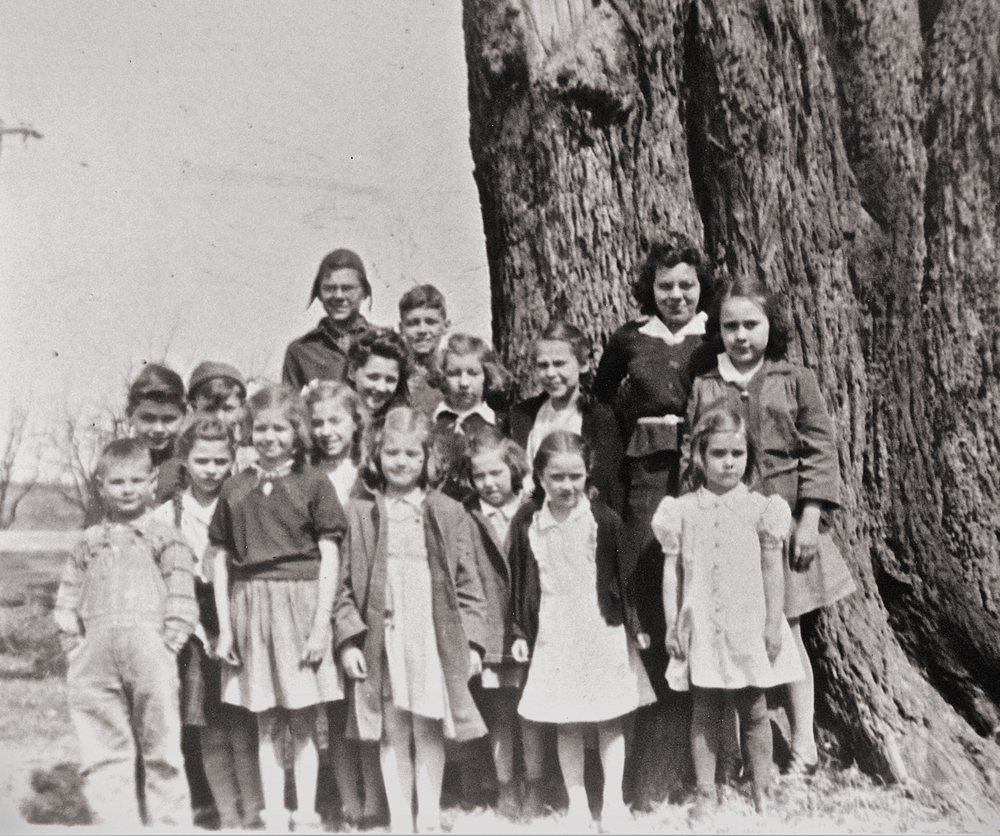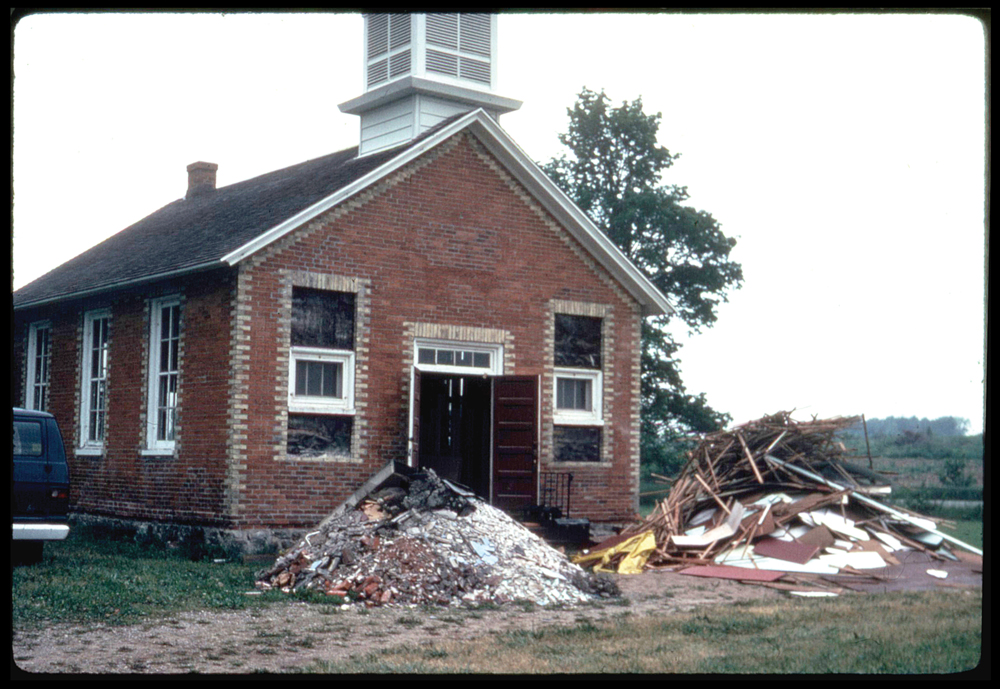One of the oldest one-room schoolhouses in Allegan County and a State of Michigan Historic Site, the Peachbelt Schoolhouse (Ganges District No. 1) served its community for 100 years before closing in 1968.
Today, present owner Dawn Stafford uses the sturdy red-brick building as her painting studio and art gallery. Its light-flooded space provides inspiration, much as it did for generations of school children. The second-floor sleeping loft, installed by Phil and Miriam Van Eyl, comes in handy for accommodating weekend visitors.

“I used to ride my bicycle along these country roads,” reflects Stafford, who’s been at the site now for more than a decade, “and I was keeping an eye on this property. One evening a friend said, ‘If you can somehow buy this, I think you should.’”
A bit of research uncovered the building’s interesting past.
The name “Peachbelt” came from orchards that flourished along West Michigan’s coast during the 19th century. Old-timers recall how the fruit farmers exported their crops by rail and by sea, using the train terminus in Fennville and ship docks in Pier Cove. Upon arrival at their major market, Chicago, the peaches were tabbed “Michigan’s golden nuggets.”

In each rural community, a schoolhouse functioned as the social and educational center, providing a space for town meetings, voting, fundraisers, and cultural events, but especially for educating local youngsters. Peachbelt’s star alumnus Clifford Paine — who had returned to Fennville after retiring from a revered engineering career that included assisting in design and supervising construction of the Golden Gate Bridge — told his neighbor Phil Van Eyl that one schoolteacher used to instruct Peachbelt’s roomful of students, which ranged from 4-year-old “beginners” to teens.
There were two outdoor privies for boys and girls, a shed for firewood and, “We all drank from the same dipper,” Paine recalled, of the drinking water carried in a bucket from a farmhouse across the road.
Three years after Peachbelt Schoolhouse’s final bell clanged, the building evolved into a church for migrant workers, then an antique store.

By the time Phil and Miriam Van Eyl became drawn to the place in 1977, it was dilapidated and filled with old furniture, and the couple was able to negotiate an agreeable price.
Learning Curve
Almost immediately, Phil regretted their new purchase. “As I was sitting in the middle of an empty floor looking at all that needed to be done,” he reflects. “I was hoping that someone would knock on the door and offer me $1 for the place. I might have taken it.”
Instead, he and Miriam mortgaged their home to finance the restoration of what would become their weekend cottage. A psychology professor at Hope College, Phil taught himself how to repair brickwork, to sand and seal, to remove and replace virtually all of the previous repair work that had kept the old schoolhouse from falling apart the last 100 years.
I remember going there for the first time after we closed. As I was sitting in the middle of an empty floor looking at all that needed to be done, I was hoping that someone would knock on the door and offer me a dollar for the place. I might have taken it.
— Phil Van Eyl
To find authentic materials, the Van Eyls searched demolition sites, lumberyards and junkyards; a demolished furniture store in Holland was, to their delight, the source of used Veneklasen brick, locally produced in the 19th century. Phil hired his 10-year-old son, Paul, to chip away the cement, and the family restored the distinctive red-brick schoolhouse, with yellow brick quoins at the corners.
A sales rep from DeLeeuw Lumber led Phil to a Chicago lumberyard, where he located five-panel front doors to match the originals. Finding an old school bell, he notes, “just like the one that used to be there,” was a special thrill.
Three years of intensive restoration transformed the old schoolhouse into a “tailor-made” spot for hosting dinner parties. But Phil says he soon began to realize that “so much of our love for Peachbelt had been in the process of getting it all done.” A few years after they had completed their work, they put the building back on the market.

Seeing the “For Sale” sign, a young woman living down the street with her husband thought the schoolhouse would be a perfect retirement cottage for her parents, George and Ann Sharrard. The couple agreed, and for the next 20 years journeyed to Peachbelt from Massachusetts to spend summers in Michigan. Adding their own touches of Americana, the Sharrards acquired a historical marker and added a tall flagpole on the front lawn. They also installed a second-floor bathroom and a skylight above the sleeping loft.
But in 2003 — after the Sharrards decided to call Florida home — Peachbelt Schoolhouse became vacant once again.
History Lesson
In nearby Saugatuck, a post-college visit to her sister had evolved for Dawn Stafford into a decade of working in a historic carriage house-turned-improvised paint studio. “It was time for me to put down some roots,” she reflects, and for her, the historic brick structure exuded familiarity and comfort.

“I’m from New York State,” Stafford explains. “We have similar little towns, orchards, one-room schoolhouses.” The picturesque spot also suited her inclination to paint the local landscape and architecture, the ripening fruit from nearby orchards and nostalgic subjects.
The one structural element left unfinished during previous restorations was Peachbelt’s old roof, and it immediately called for Stafford’s attention. “The schoolyard was strewn with deteriorating shingles after every windstorm,” she recalls. “After spending the winter months refurbishing the interior, I realized I’d better not wait too long to restore the roof.”
While the artist planned her upcoming fall wedding, she studied Preservation Brief #29 (“The Repair and Replacement of Historic Wooden Shingle Roofs”) supplied by the Michigan Department of History, Arts and Libraries, visited lumber yards and interviewed different contractors. After roofer Joe Larsen removed three layers of material and Stafford saw the original decking — made of assorted woods and secured with only one nail at the end of each board — she knew that the waiting new shingles wouldn’t be right.
We rested our bicycles on the shoulder of 63rd Street on a muggy August evening. I remember noticing all the different species of wildflowers blooming in the lawn and how the little school glowed in the waning light. My friend Catherine offered, ‘I don’t know much about real estate, Dawn, but if you can somehow buy this, I think you should try!’
— Dawn Stafford
“They were too rustic, not smooth,” she says, “so I had all eight pallets shipped back and ordered eight pallets of ‘starter-course’ shingles.” Larsen hand-nailed each of them because, he explained, a pneumatic nail-gun would exert too much pressure.
With characteristic attention to detail, the schoolhouse’s new owner also had a crushed concrete driveway installed, refinished the old woodshed, created a walkway of antique bricks recycled from the streets of nearby St. Joseph and planted flowering trees and perennials to replace “the healthiest poison ivy” she had ever seen.
Indoors, recessed lighting was selected for the ceiling to highlight Stafford’s paintings and figural clay sculpture crafted by Jill Lareaux, an artist she also exhibits her schoolhouse-turned gallery.

In April, 2006, the Saugatuck-Douglas Historical Society presented Stafford with a Heritage Preservation Award; two months later, she hosted approximately 300 people at Peachbelt Studio and Gallery’s Grand Opening.
“It was so much fun getting to know so many people,” relates Stafford, who was invited to speak at the Michigan One-Room Schoolhouse Association Conference this May in Eaton Rapids (one-roomschool.org). Fennville residents, she says, shared her happiness in the historic site’s newest turn.
“They had also wanted to restore the place where they and their children had gone to school,” she says. “It was the pride of the community.”
Learn more at peachbeltstudio.com. Freelance writer Barbara Stodola resides in Indiana.

As a protective worker for the Michigan Department of Social Services, Miriam traveled the highways and byways of Allegan County. Over the years she became quite familiar with every shortcut, lots of interesting landmarks and places of scenic beauty. She talked at length about the many one-room schoolhouses that were still around and thought it such a shame that they were being abandoned, torn down… One day she offered, “Wouldn’t it be nice if we bought one of those places and fixed it up?”
The schoolhouse we selected was a few miles west of Fennville, Michigan on M-89.
It was called Peachbelt.
— Excerpted from “Reflections” by Phil Van Eyl (1994)
Details of the Van Eyl Restoration
- Repair of the fieldstone foundation and exterior brickwork. Sealant appliedto bricks
- Burial of the electrical and phone lines and removal of a telephone pole, to give the building a more 19th century look
- Installation of a hanging gas furnace and sump pump in crawl space
- Replacement of front door and school bell
- Restoration of two front windows to match eight other originals
- Installation of back door
- Restoration of the chimney, per 1896 photograph
- Removal of paint from window frames, repainting and construction of new screens
- Removal of four layers of acoustical tile from ceiling and patching of original wood ceiling
- Removal of vinyl floor tiles and sanding of maple floor beneath
- Addition of new wiring, insulation and dry wall
- Removal of all indoor plumbing and addition of new pipes, fixtures, etc.
- Installation of kitchen sink, stove and cabinets
- Installation of sleeping loft and stairway to second floor.
- New point and motor on existing well.








Facebook Comments